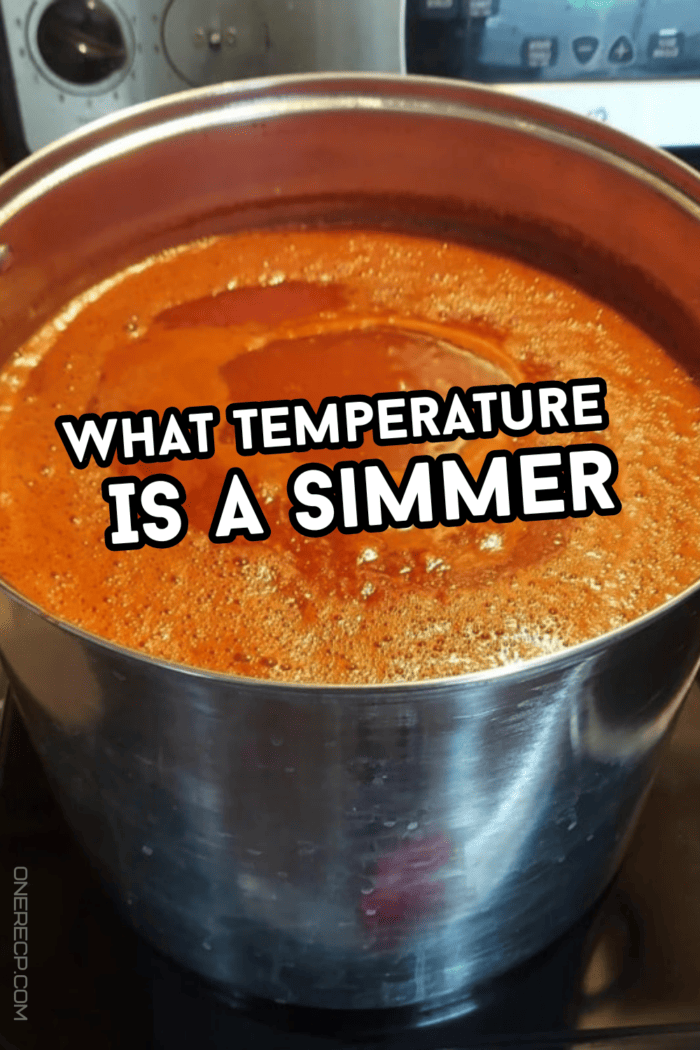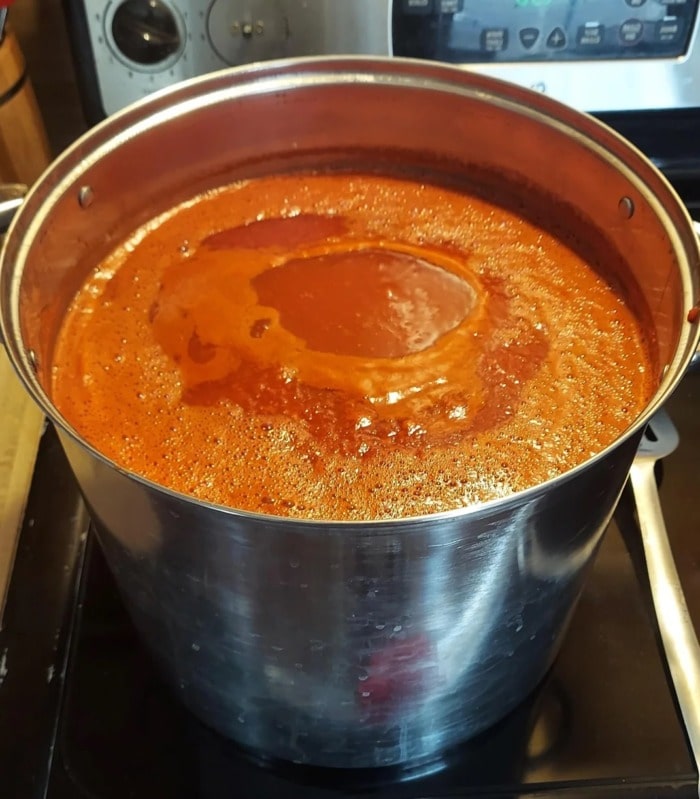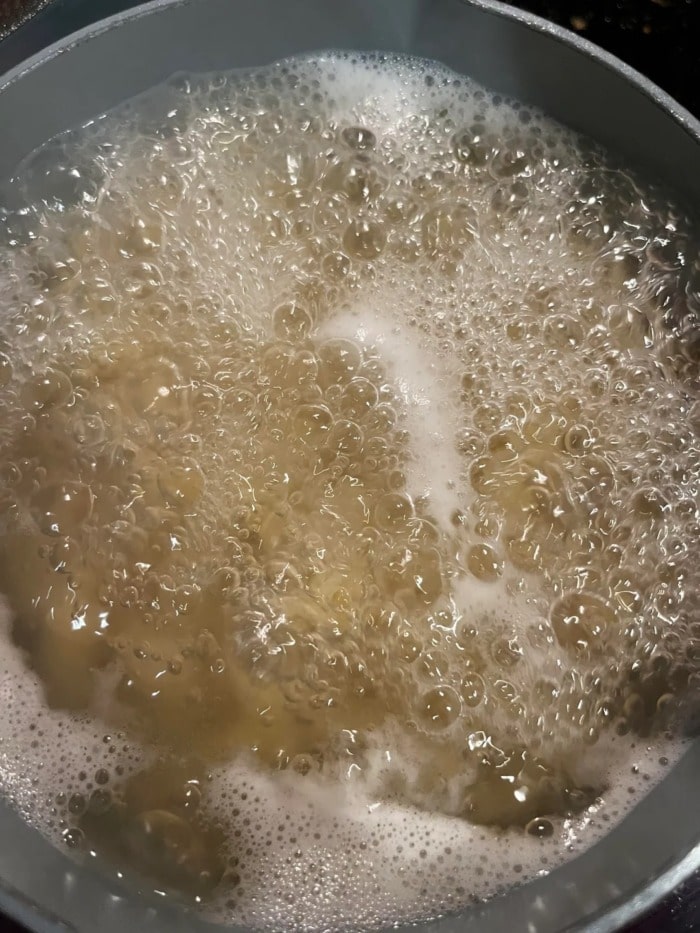When I first began cooking, I had difficulties telling when a pot of water was simmering and not boiling.
And since I relied on my trusty thermapen more than my senses, I decided to check what the temperature of simmer is for different cooking liquids.
Fortunately, after I gained some experience I also found how to tell if a pot of water is simmering without a thermometer.
In this article, I’ll share my findings with you and also explain the differences between boiling and simmering.

What’s the temperature of a simmer?
Simmering is a moist-heat cooking technique in which a liquid is heated just below its boiling point.
In other words, a liquid starts to simmer when it reaches a temperature of 180 – 190°F (82 – 88°C).
This temperature range is sometimes labeled as a low simmer, while temperatures between 190°F (88°C) and 210°F (98°C) are regarded as a simmer.
Having said that, checking the temperature of a liquid isn’t the most practical way to tell if it’s simmering or not.
What you can do instead is to simply observe the surface of the water or liquid you’re cooking with.
When water is simmering, there are small bubbles rising from the bottom of the pot up to the surface.
Once these bubbles reach the surface, they break apart and cause the water to shimmer.
In order to illustrate this process, I brought a pot of water to a simmer and took a snapshot.
Here’s what simmering looks like in a pot of tomato sauce:

by BluRayVen
And here’s what a pot of noodle water looks like when it’s boiling:

by ungovernable_fable
As you can see, boiling creates far more water agitation that causes the liquid to churn vigorously.
This creates larger pockets of air that burst and disturb the water surface once they reach the top.
Boil vs Simmer: What are the differences?
Even though boiling and simmering seem quite similar, they’re two distinct methods that are used for different culinary purposes.
These are the most important differences between both methods:
- Boil has higher temperature. The biggest difference between boiling and simmering is temperature. A liquid starts boiling at a temperature of 212°F (100°C) at sea level, whereas simmering occurs at 180°F (82°C). It’s also worth pointing out that these temperatures decrease by 1 degree for every 500 feet of elevation. This means that at 3000 feet above sea level, the boiling point of water would be 208°F instead of 212°F.
- Boiling cooks food faster. Since simmering occurs at a lower temperature, it cooks foods slowly and takes more time than boiling.
- Different culinary application. Simmering is typically used to make soups, stews and pot roast because it allows all of the seasonings and ingredients to infuse the cooking liquid with flavor. In addition, its lower temperature helps to break down the connective tissues in meat. Due to this, it’s often used as a way to make tough cuts of meat such as beef, pork shoulder, and chicken thighs more tender. Boiling, on the other hand, is most often used for hard-boiled eggs, pasta and legumes.
- Simmering does not create as much bubbles. The higher temperature of boiling exerts more energy on the water molecules and increases water activity. This makes the water churn vigorously and creates large bubbles that burst upon reaching the surface. Simmering, in contrast, is a much gentler process that creates less water disturbance.
Related: How to Know When Boiled Chicken is Ready?
What setting is simmering on the stove?
The heat control settings on most stoves either come as a numbered dial or are labeled as low, medium and high.
If the controls on your stove are numbered, then you should set them to 3 or 4 for simmering.
Otherwise, you should either use the low or medium heat setting if you want to bring a liquid to a simmer.
Having said that, it’s worth pointing out that simmering is more of a state rather than just a setting on your stove.
Therefore, the amount of heat you’ll need to reach this state will depend on the type of your stove as well as the pot you’re using.
Gas stoves, for instance, heat up significantly faster than electric ones and have better heat controls.
Due to this, maintaining a simmer on a gas stove is much easier than it is on an electric stove.
Since it’s impossible to account for all variables, it’s more practical to let a liquid come to a boil and then bring it down to a simmer.
The bottom line
In order to simmer a liquid, you need to heat it up until it reaches a temperature of at least 180°F (82°C).
You can tell you’ve reached this temperature by simply observing the surface of the liquid.
As long as there are a lot of small bubbles that don’t cause the liquid to churn vigorously, you can safely assume it’s simmering.